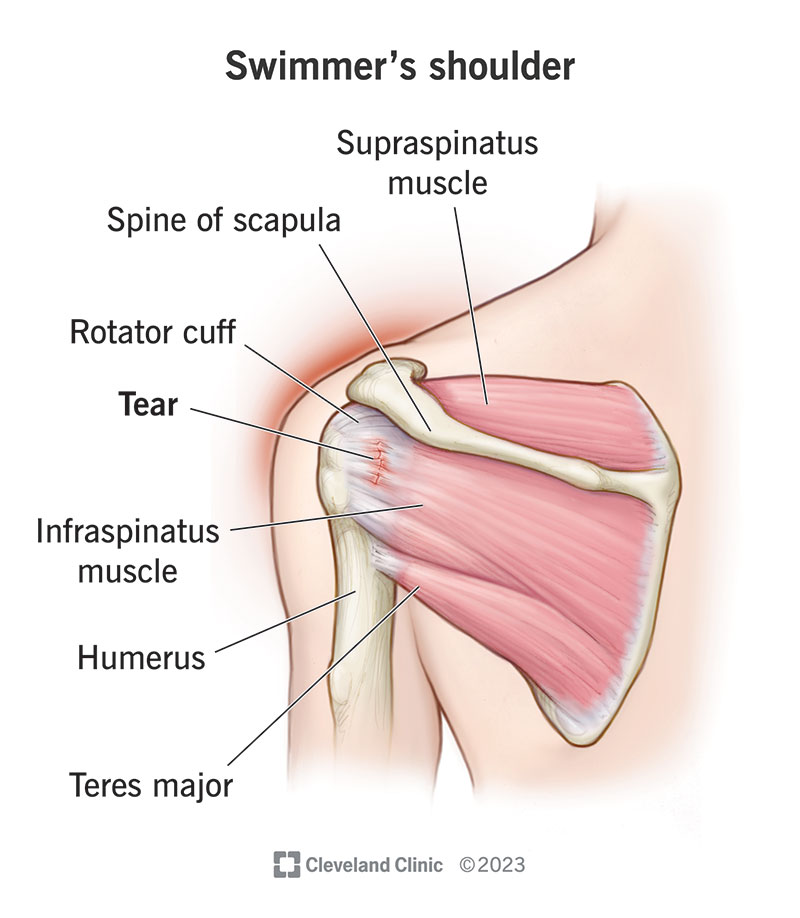Swimmer’s shoulder is any of a few types of shoulder issues that cause pain, weakness and instability. Providers group them together as swimmer’s shoulder because it’s common among high-level swimmers or people who train competitively. You’ll need at least a few weeks of rest, at-home treatments and physical therapy to help your shoulder heal.
Advertisement
Cleveland Clinic is a non-profit academic medical center. Advertising on our site helps support our mission. We do not endorse non-Cleveland Clinic products or services. Policy

Swimmer’s shoulder causes shoulder pain, weakness and other symptoms in your shoulder joint. It’s a broad name for a few different issues that cause similar symptoms.
Advertisement
Cleveland Clinic is a non-profit academic medical center. Advertising on our site helps support our mission. We do not endorse non-Cleveland Clinic products or services. Policy
It gets its name from who it usually affects — swimmers and other athletes who use their shoulders a lot to move their arms overhead.
Your shoulder is a complex joint where bones, muscles and connective tissue (tendons and ligaments) come together to let you move your arms. If you swim, play another sport that puts stress on your shoulder or do physical work, you’re more likely to irritate tissue in your shoulder.
Visit a healthcare provider if you have shoulder pain that lasts longer than a week.
Healthcare providers refer to several different shoulder conditions as swimmer’s shoulder. Your provider might say that you have a more specific issue, including:
Advertisement
It’s hard to know exactly how common swimmer’s shoulder is because providers use the term as a catch-all for so many different types of shoulder issues. Experts estimate that at least one-third of elite competitive swimmers have had some type of swimmer’s shoulder.
However, it’s probably even more common than that, especially among amateur athletes, people who play other sports and people who hurt their shoulders doing physical work.
The most common swimmer’s shoulder symptoms include:
Swimmer’s shoulder happens when something puts repeated stress and strain on your shoulder joint. Over time, the extra stress irritates your tissue. The irritated tissue develops tiny tears, leading to inflammation and scar tissue. This damage prevents your joint from moving smoothly.
It might sound obvious, but swimming is the most common cause of swimmer’s shoulder. More specifically, training competitively or swimming often for exercise causes it. Swimming is great exercise, but it can put a lot of pressure on your shoulder joints — especially if you’re intentionally pushing your body to improve your strength, speed and race times.
Any activity or job that makes you use your shoulder for a repetitive motion with your arms over your head can cause swimmer’s shoulder. It’s common in sports that require lots of throwing (like baseball) or physical jobs (like swinging a hammer or using heavy tools).
A healthcare provider will diagnose swimmer’s shoulder with a physical exam. They’ll examine your shoulder and ask about your symptoms. Tell your provider when you first noticed pain or other symptoms and if any activities make them worse.
Your provider will also check your shoulder’s range of motion (how far you can move it) and strength. They’ll compare it to your other, uninjured shoulder.
You may need imaging tests to take pictures of your shoulder joint and the tissue around it, including:
Your provider will suggest treatments to relieve your pain and reduce stress on your shoulder joint. The goal of treating swimmer’s shoulder is to prevent more damage inside your joint and to help your shoulder regain its normal function. The most common swimmer’s shoulder treatments include:
Advertisement
Swimmer’s shoulder isn’t cured the same way some infections are — there’s no set end date when your provider can say that you’ve taken a full course of antibiotics and the infection is gone. But it’s usually a temporary issue.
Most people with swimmer’s shoulder start to feel better in a few weeks after starting treatment. Don’t return to swimming or other training before your provider says it’s safe, even if your symptoms are improving.
The best way to prevent swimmer’s shoulder is to avoid overusing your shoulders:
Everyone has a different swimmer’s shoulder recovery time. How long it’ll take depends on how quickly your shoulder heals, and how much irritation or damage there was inside your joint.
It usually takes at least a few weeks to recover enough to resume training, but it can take a month (or longer) for your shoulder to heal completely.
Advertisement
You can reduce your risk of developing swimmer’s shoulder by:
Don’t resume swimming or other physical activities before your healthcare provider says it’s safe. If you stress your shoulder again before it has time to heal, you’re more likely to reinjure it. This can increase your risk of more severe injuries like a torn rotator cuff or SLAP tear.
Visit a healthcare provider as soon as you notice symptoms like pain, swelling or a decreased range of motion in your shoulder.
Go to the emergency room if you’ve experienced trauma, can’t move your shoulder or think you might have a dislocated shoulder. Never try to force your shoulder back into place on your own.
You may want to ask your healthcare provider:
Any injury is frustrating for an athlete. That’s especially true when you’re training to perform your best and end up hurt. Swimmer’s shoulder might mean you have to take a break from training or working out for a few weeks, but that time off is worth it.
Advertisement
Don’t rush your recovery — listen to your body and give your shoulder all the time it needs to recover. The damage in your shoulder is temporary, but your shoulder needs time to heal before you can dive back into your training.
Living with constant shoulder pain? Cleveland Clinic can help you get the relief you need with personalized treatment plans that match your needs.

Last reviewed on 12/07/2023.
Learn more about the Health Library and our editorial process.